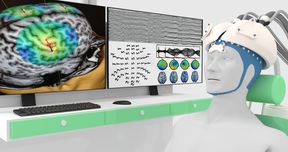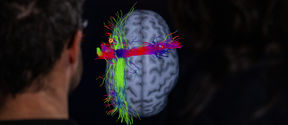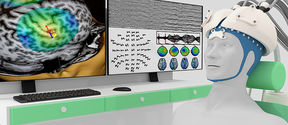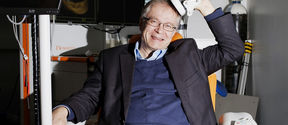Description of the research
We develop new technology for transcranial magnetic stimulation (TMS) to improve targeting accuracy, pulse-shape control, and closed-loop target and timing adjustment based on real-time feedback, e.g., from electroencephalography (EEG) or electromyography (EMG) measurements.
We have pioneered multi-locus TMS (mTMS), in which a set of coils allows rapid electronic stimulation targeting without transducer movement (Koponen et al. 2018). We are pushing the boundaries and aim to integrate our mTMS technology into a 3-tesla human magnetic resonance imaging (MRI) scanner at Aalto University and into a small-animal 9.4-tesla MRI device at the University of Eastern Finland (www.aalto.fi/news/one-million-euro-for-research-on-electromagnetic-brain-stimulation). Our endeavour builds on our recently established understanding on how to design energy-efficient, optimized TMS coils (Koponen et al. 2015, 2017, 2018).
Combined TMS–EEG provides a valuable tool for probing the excitability and connectivity in the brain. For interpreting the recorded data, we develop advanced signal processing techniques for several applications of EEG analysis: artefact rejection (Mutanen et al. 2016, 2018), source localization (Mäkelä et al. 2018), blind source separation (Metsomaa et al. 2017), and connectivity analysis. Artefact rejection is of special interest since TMS-induced artefacts are a great challenge when interpreting EEG data. We use a wide range of tools, from classical deterministic methods to Bayesian inference as well as from physical model-based analysis to fully data-driven approaches.
TMS is used in clinically in diagnostics and therapy. Navigated TMS is nowadays the most accurate noninvasive method to locate brain areas responsible for movement production and is used to locate eloquent cortex preoperatively in brain tumour and epilepsy patients waiting for surgical treatment. Repetitive TMS, on the other hand, is used in the treatment of depression, neuropathic pain, tinnitus, and stroke. We conduct neurophysiological experiments, usually by combining TMS with EEG, EMG, or speech recordings, on healthy subjects and patients to improve the understanding of brain functioning and to develop new paradigms. We develop technology and methods that provide enhanced means for neuroscience as well as for clinical diagnostics and treatment.
Science Factory: TMS-EEG Summer School and Workshop
The TMS group organizes annually a learning event titled Science Factory: TMS–EEG Summer School and Workshop in Espoo, Finland. With our Science Factories, we aim at enhancing the interaction and discussion within the international TMS–EEG community.
During the intensive week, top-notch experts and beginners in the field share their ideas and learn from each other. Various learning methods, for example, lectures, whiteboard discussions, small-group work, live programming, and science pitching are used. In addition, numerous hands-on sessions for experiments and data analysis are organized to obtain comprehensive TMS–EEG experience and to train well-rounded young researchers.
Past Science Factories
11th Science Factory: TMS–EEG Summer School and Workshop 24–30 May 2025
10th Science Factory: TMS-EEG Summer School and Workshop (2024)
9th Science Factory: TMS-EEG Summer School and Workshop (2023)
8th Science Factory: TMS-EEG Summer School and Workshop (2022)
7th Science Factory: TMS-EEG Summer School and Workshop (2019)
6th Science Factory: TMS-EEG Summer School and Workshop (2018)
5th Science Factory: TMS-EEG Summer School and Workshop (2017)
4th Science Factory: TMS–EEG Summer School (2016)
3rd Science Factory: TMS–EEG Summer School (2015)
2nd TMS–EEG Summer School: Probing Brain Dynamics (Science Factory, 2014)
Coupling to the dynamics of the human brain with TMS–EEG (Science Factory, 2013)





















